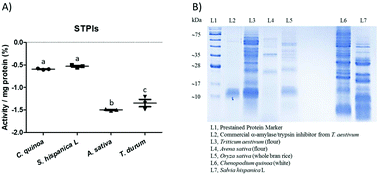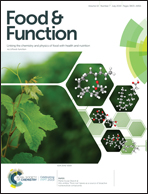Plant seed protease inhibitors differentially affect innate immunity in a tumor microenvironment to control hepatocarcinoma
Abstract
Identifying tolerance responses to ingested foodstuff over life is essential for understanding dysfunction in metabolic diseases. This study presents a comparative structural and functional analysis of serine-type protease inhibitors (STPIs) from Chenopodium quinoa, Salvia hispanica L., Avena sativa and Triticum durum. It also evaluates their influence on an in vivo hepatocarcinoma (HCC) model. STPIs are found in all samples with significant differences in protease inhibitory capacity: C. quinoa = S. hispanica < A. sativa = T. durum. STPIs in C. quinoa and S. hispanica appear as heterologous complexes, while those in A. sativa are present as homologous complexes. T. durum provides different subunits with STPI capacity. HPLC-RP-ESI analyses revealed homology between STPIs in the different samples and the partial resistance of those to simulated gastrointestinal digestion. In vivo, STPIs from S. hispanica showed the most positive effects, increasing F4/80+ cells normalizing the expression (mRNA) of CD36 and the innate immune ‘Toll-like’ receptor (TLR)-4. Only STPIs from C. quinoa and S. hispanica did not impair the production of inflammatory mediators (granulocyte–monocyte colony stimulating factor, stem cell factor and TNFα), contributing to maintaining the polarization of the antitumoral M1 macrophage phenotype. These structural and functional features of STPIs from C. quinoa and S. hispanica can be used to control HCC aggressiveness.



 Please wait while we load your content...
Please wait while we load your content...